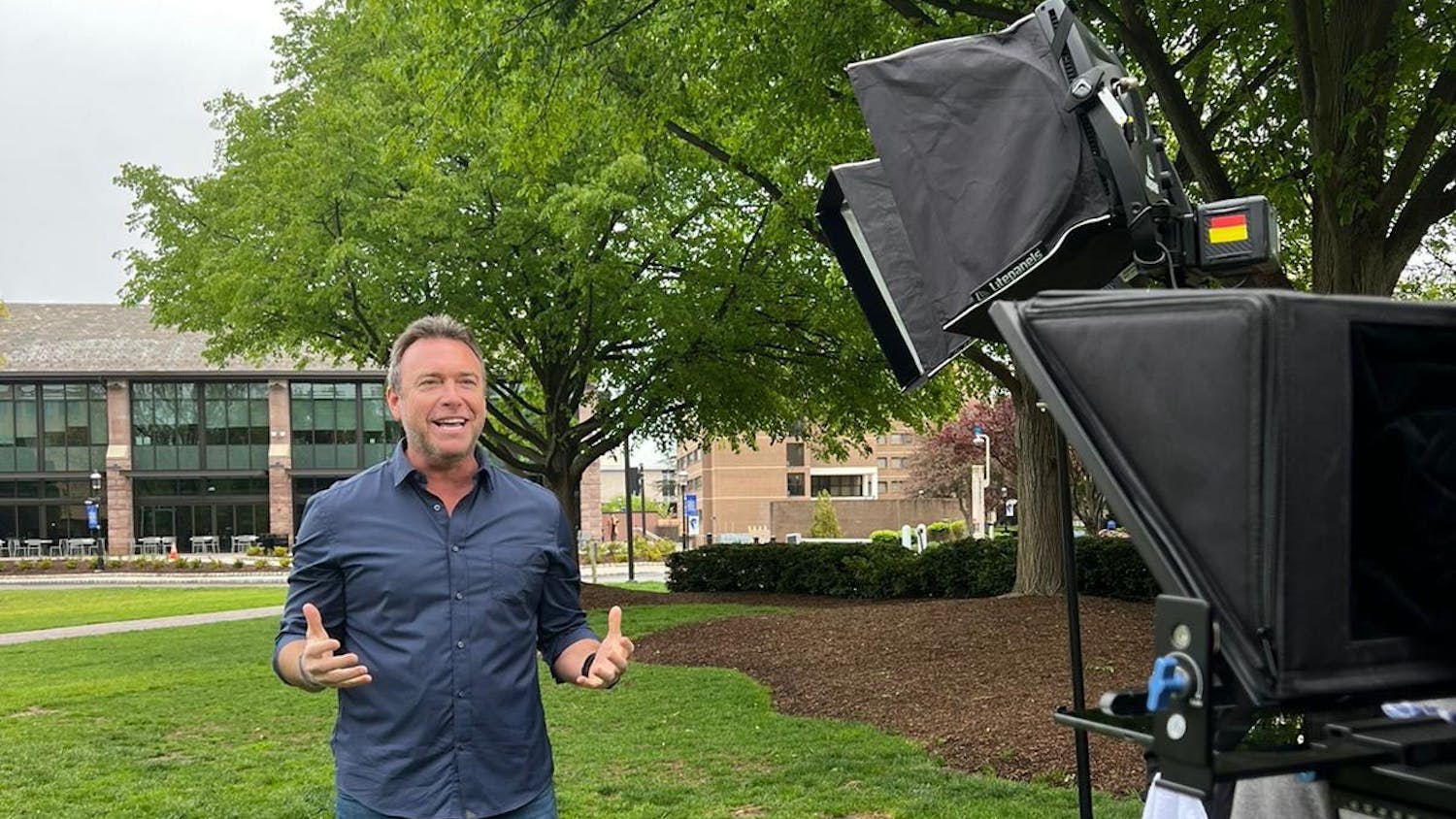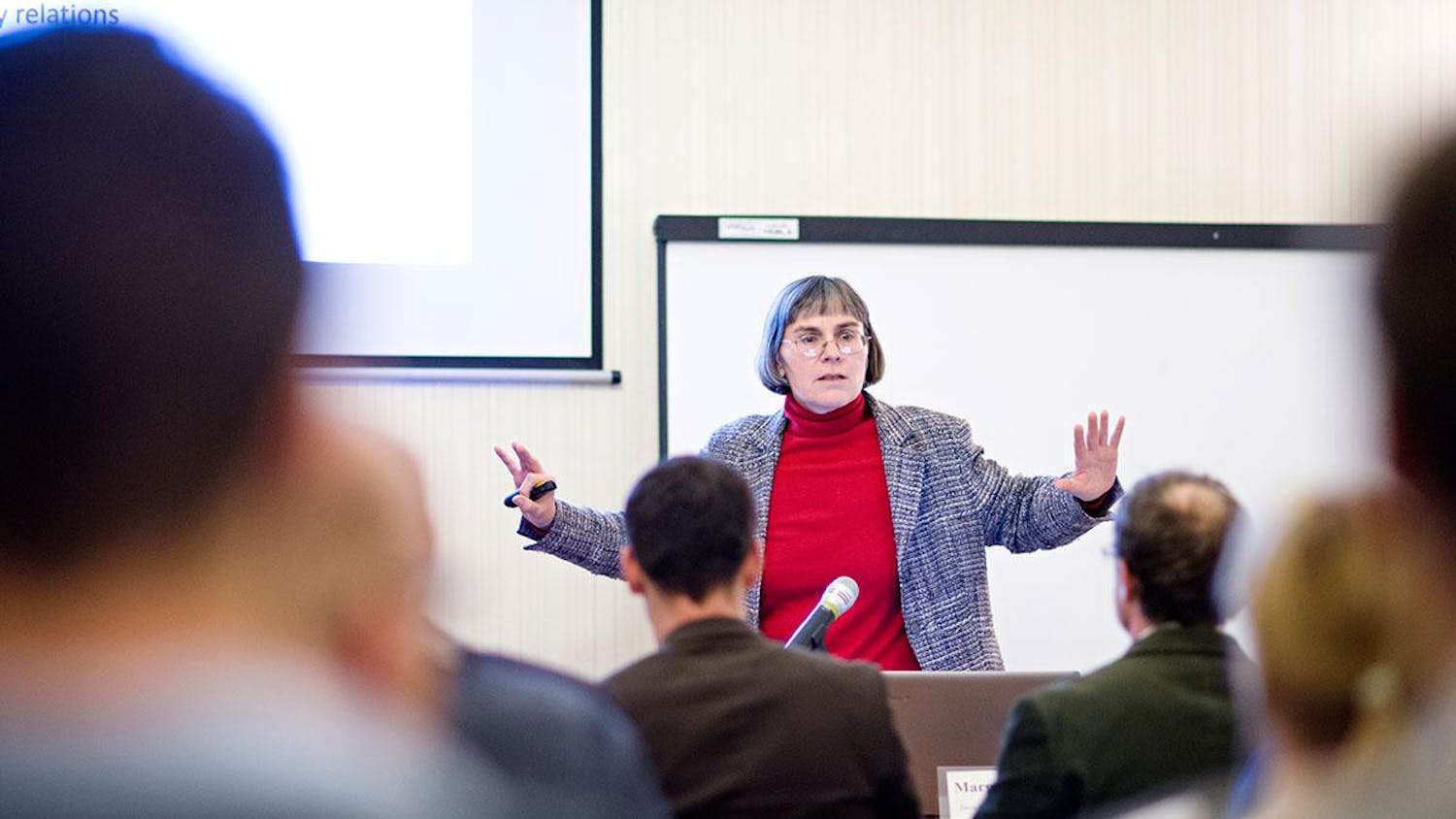[caption id="attachment_13414" align="alignnone" width="300"] © Joey Khan Photography[/caption]
The popular Humans of New York photographer has been a storyteller from his early days. When he attended the University of Georgia, he was a history major, studying the stories of dead individuals. He said he loves reading biographies because they are the rawest form of history.
Last week, on Feb. 18, SHU Speaks brought Brandon Stanton to Seton Hall, where he pressed the pause button on telling other people’s stories and told his own. As a street photographer, Stanton’s claim to fame has been through his blog, Humans of New York (HONY), where he mostly posts portraits of ordinary people living and working in New York City, accompanied by snippets of conversations about their lives.
“You can’t learn or connect with history more than learning about the history of an individual,” Stanton said in an interview before the event. “When you see what decisions a person made in any given situation, that’s what you can really learn from. To see somebody who is in an extraordinary circumstance and learn the decisions they made…that is the best education you can possibly get.”
During his speech, Stanton told students about the story of his famous blog.
“One day I was on the subway and I saw these people and these two kids who didn’t know one
another,” Stanton shared during his speech. “They both had this same look and expression. When I looked at this picture, I realized I had a shot of being a photographer... I got over this fear so I was able to take a photo that not a lot of people could take. I could create a world that could talk.”
After this moment, the photographer set out to take pictures every single day. He was capturing moments and didn’t interview anyone. Stanton shares that HONY didn’t begin as a blog that told other people’s stories.
“I’d say the main theme of the evening is that HONY wasn’t this fully formed idea that I had and then executed,” Stanton revealed. “It was more of a process of hundreds of small evolutions that came out of me going out and photographing every single day. If there’s one main takeaway from the story, it’s that if I had waited to have the perfect idea, I would have never started.”
He advises students: You’ll stand out more if you’re different. After he learned this, Stanton began to wonder what it was about the people he was stopping to photograph that made them different.
“I found that it’s almost never their philosophy,” he shared. “It’s their story.”
When he stops people on the street, he asks them questions like about their happiest, saddest and angriest moments of their life.
“I follow my natural curiosity when listening to these stories,” he said.
Through interviewing people, Stanton learned that there are two threads of an interview: vulnerability and validity.
“First, vulnerability. Feeling exposed as you open up,” he said. “Then there’s this feeling of validation that someone cares about what you have to say.”
Stanton told students that people appreciate being heard. “There are a lot of people who don’t have anything to offer, but their story,” he said. “It validates their existence. Even if it’s a story or a lesson.”
Going through this six year journey, Stanton has learned that following your dreams takes a lot of hard work. He advises students to avoid using their dreams as an excuse to not work as hard.
While Stanton certainly couldn’t predict his success, he now has 16.9 million likes on Facebook and around 4.9 million followers on Instagram. By giving speeches and selling his books, Stanton has made a living through his passion.
“When my first book came out, I had a book signing and that was the first time a large amount of my fans gathered in one place,” he said. “That was surreal. Up until that point, everything was online, through likes, comments and emails. Then to walk into that room and see hundreds of people there…That’s real people. Since then, it’s been very incremental.”
Now, six years later, Stanton gets to travel and connect with his fans through his speeches and book signings. “It’s a deeper level of connection with people who follow the blog,” he said. “Talking to someone face-to-face, there’s more of an emotional exchange and more of an interaction. That’s the biggest benefit to me and hopefully to the people who come out.”
Fiorella Calderon, a junior biology major, said the speech was inspirational.
“It was very nice to hear a young individual come to campus and talk about the essence of working hard for what you want to do,” she said. “It was refreshing to hear someone so passionate about what they want to do.”
One of the main messages of Stanton’s speech was that life is a discovery process and isn’t necessarily about a giant burst of inspiration.
“It’s just tinkering innovation and it’s a process I’m still going through today,” he said.
From the early days to now, rejection is a big part of what Stanton goes through on a daily basis as walking up to strangers and asking them to tell their personal story isn’t necessarily easy.
“People are rude all the time,” he said. He recalls walking up to mentally unhinged individuals who started screaming at him. “I didn’t realize until I had walked up to them,” he added.
While many people might quit after those negative experiences, Stanton does say that it was very demotivating.
“Especially in the beginning when I didn’t have a lot of followers or fans and was trying to get things going,” he said. “When five or six people in a row are rude, it makes you want to go home and lay in bed. But it’s easier now that I’m used to it. It still happens and I just need to sit down and regroup.”
Stanton wants students to learn to work hard for success which is what the Students Activities Board (SAB) wanted students to learn from his speech.
Shruti Sharma, a freshman concert co-chair of the Student Activities Board, said that SAB brought Stanton to campus because they thought students could relate to his mission and his message.
Sharma added that the goal was to inspire students of Seton Hall to do something that is bigger than themselves, for them to leave their imprint on the world and to make a change in society, just like Stanton has done.
Rebecca White can be reached at rebecca.white@student.shu.edu.
Nisha Desai can be reached at nisha.desai@student.shu.edu.
© Joey Khan Photography[/caption]
The popular Humans of New York photographer has been a storyteller from his early days. When he attended the University of Georgia, he was a history major, studying the stories of dead individuals. He said he loves reading biographies because they are the rawest form of history.
Last week, on Feb. 18, SHU Speaks brought Brandon Stanton to Seton Hall, where he pressed the pause button on telling other people’s stories and told his own. As a street photographer, Stanton’s claim to fame has been through his blog, Humans of New York (HONY), where he mostly posts portraits of ordinary people living and working in New York City, accompanied by snippets of conversations about their lives.
“You can’t learn or connect with history more than learning about the history of an individual,” Stanton said in an interview before the event. “When you see what decisions a person made in any given situation, that’s what you can really learn from. To see somebody who is in an extraordinary circumstance and learn the decisions they made…that is the best education you can possibly get.”
During his speech, Stanton told students about the story of his famous blog.
“One day I was on the subway and I saw these people and these two kids who didn’t know one
another,” Stanton shared during his speech. “They both had this same look and expression. When I looked at this picture, I realized I had a shot of being a photographer... I got over this fear so I was able to take a photo that not a lot of people could take. I could create a world that could talk.”
After this moment, the photographer set out to take pictures every single day. He was capturing moments and didn’t interview anyone. Stanton shares that HONY didn’t begin as a blog that told other people’s stories.
“I’d say the main theme of the evening is that HONY wasn’t this fully formed idea that I had and then executed,” Stanton revealed. “It was more of a process of hundreds of small evolutions that came out of me going out and photographing every single day. If there’s one main takeaway from the story, it’s that if I had waited to have the perfect idea, I would have never started.”
He advises students: You’ll stand out more if you’re different. After he learned this, Stanton began to wonder what it was about the people he was stopping to photograph that made them different.
“I found that it’s almost never their philosophy,” he shared. “It’s their story.”
When he stops people on the street, he asks them questions like about their happiest, saddest and angriest moments of their life.
“I follow my natural curiosity when listening to these stories,” he said.
Through interviewing people, Stanton learned that there are two threads of an interview: vulnerability and validity.
“First, vulnerability. Feeling exposed as you open up,” he said. “Then there’s this feeling of validation that someone cares about what you have to say.”
Stanton told students that people appreciate being heard. “There are a lot of people who don’t have anything to offer, but their story,” he said. “It validates their existence. Even if it’s a story or a lesson.”
Going through this six year journey, Stanton has learned that following your dreams takes a lot of hard work. He advises students to avoid using their dreams as an excuse to not work as hard.
While Stanton certainly couldn’t predict his success, he now has 16.9 million likes on Facebook and around 4.9 million followers on Instagram. By giving speeches and selling his books, Stanton has made a living through his passion.
“When my first book came out, I had a book signing and that was the first time a large amount of my fans gathered in one place,” he said. “That was surreal. Up until that point, everything was online, through likes, comments and emails. Then to walk into that room and see hundreds of people there…That’s real people. Since then, it’s been very incremental.”
Now, six years later, Stanton gets to travel and connect with his fans through his speeches and book signings. “It’s a deeper level of connection with people who follow the blog,” he said. “Talking to someone face-to-face, there’s more of an emotional exchange and more of an interaction. That’s the biggest benefit to me and hopefully to the people who come out.”
Fiorella Calderon, a junior biology major, said the speech was inspirational.
“It was very nice to hear a young individual come to campus and talk about the essence of working hard for what you want to do,” she said. “It was refreshing to hear someone so passionate about what they want to do.”
One of the main messages of Stanton’s speech was that life is a discovery process and isn’t necessarily about a giant burst of inspiration.
“It’s just tinkering innovation and it’s a process I’m still going through today,” he said.
From the early days to now, rejection is a big part of what Stanton goes through on a daily basis as walking up to strangers and asking them to tell their personal story isn’t necessarily easy.
“People are rude all the time,” he said. He recalls walking up to mentally unhinged individuals who started screaming at him. “I didn’t realize until I had walked up to them,” he added.
While many people might quit after those negative experiences, Stanton does say that it was very demotivating.
“Especially in the beginning when I didn’t have a lot of followers or fans and was trying to get things going,” he said. “When five or six people in a row are rude, it makes you want to go home and lay in bed. But it’s easier now that I’m used to it. It still happens and I just need to sit down and regroup.”
Stanton wants students to learn to work hard for success which is what the Students Activities Board (SAB) wanted students to learn from his speech.
Shruti Sharma, a freshman concert co-chair of the Student Activities Board, said that SAB brought Stanton to campus because they thought students could relate to his mission and his message.
Sharma added that the goal was to inspire students of Seton Hall to do something that is bigger than themselves, for them to leave their imprint on the world and to make a change in society, just like Stanton has done.
Rebecca White can be reached at rebecca.white@student.shu.edu.
Nisha Desai can be reached at nisha.desai@student.shu.edu.

Comments




